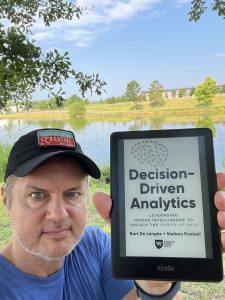Do you ever find yourself bogged down in minutiae, buried in tasks and decisions that don’t seem to matter? Perhaps you spend time mining data and information with no specific goal in mind. Although details do matter, some decisions and details matter more than others. Recently, I encountered a situation where a client was obsessing over offering a product discount of 15% vs. 20%. Financial models showed the expected profit difference to be negligible, but the client wanted more precision and was willing to expend a lot of resources to get it—too much, in fact. Indeed, getting a precise forecast of consumer spending is very hard to do—ask any large company that spends millions trying to do that very thing.
Sometimes, you just need to make a decision and move on, making improvements once results come in later so that you have better data. I’ve called that being “directionally correct.” My client’s decision-making process had become too complex without significant benefit. It’s a classic example of wasting dollars to save pennies. If you’re an accountant or business analyst, you have my permission to skip the next three paragraphs of this article.
In business, there’s a technique for decision-making known as the cost-benefit analysis. I want to give you a classic business school definition of the concept, so let’s turn to the Harvard Business School (HBS). According to HBS, “Cost-benefit analysis involves tallying up all costs of a project or decision and subtracting that amount from the total projected benefits of the project or decision. If the projected benefits outweigh the costs, you could argue that the decision is a good one to make. If, on the other hand, the costs outweigh the benefits, then a company may want to rethink the decision or project.” (source: Harvard Business School article on cost–benefit analysis)
The most well-known quantitative measurement of a cost-benefit analysis is ROI (return on investment), which is calculated as follows:
ROI = (Total Benefits) / (Total Costs) x 100
A positive ROI means that the benefits exceed the costs, and, in general, a higher ROI is better than a lower one. A negative ROI indicates a loss. Most businesspeople have heard of ROI even if they’re not quite sure how to calculate it. There are other forms of cost-benefit measurement, but ROI is the most well-known. In marketing, we have a related measurement called ROAS, which is the Return on Advertising Spend. It’s the same concept, applied more narrowly to revenue generated by advertising spend. My company uses ROAS when helping clients plan marketing activities.
Organizations can spend lots of money trying to calculate ROI. On the cost side of the equation, you may have direct costs, indirect costs, fixed costs, and variable costs. On the benefit side of the equation, you might have direct benefits, indirect benefits, and long-term benefits (which are normally converted to present-day dollars). My MBA is in finance, and I spent several years in graduate school examining these concepts in significant detail. It’s been my experience that most small business leaders don’t truly understand the components of ROI, especially those regarding cost. Your homework is to look up the associated concepts of opportunity cost and sunk cost, two important terms we’ll examine in a future article.
Over my career, I’ve seen entire projects devoted to nothing but attempting to get an accurate calculation of ROI. Calculating ROI is a form of data-driven decision-making, which aims to improve accuracy, efficiency, and objectivity. Being data-driven, or at least data-inspired, is generally a good thing. It’s currently in fashion to say that you’re “data-driven”. I’m a numbers guy, enjoy stuff like this, and have even referred to myself as being data-driven. Recently, I attended an online webinar by two business school professors who challenged the notion of being “data-driven.” I decided to find out more.

“Decision-Driven Analytics” is a new book by Professors Bart De Langhe and Stefano Puntoni (Wharton School Press, June 2024). In their new book, the authors make the case for a decision-first approach, where analytics initiatives are driven by specific business decisions rather than generic data exploration. In short, it’s the exact opposite of being “data-driven.” Putting the decision before the data ensures that analytics efforts are directly tied to tangible business outcomes.
I found myself smiling and nodding in agreement with many of the comments made in the book. For example, they noted that some people love to focus on the little things, to the point where the accuracy doesn’t matter. I had to laugh when I read, “When the numbers involved are more precise, people are more likely to engage in unnecessary calculations.” We all know people like that. I’ve been like that myself. Don’t be that person!
There’s an entire discussion about “confirmation bias,” which is the tendency to seek and interpret new data as confirmation of one’s existing beliefs. Much can be said about the current problems we have in society with confirmation bias and how algorithmically generated content and data can feed into that. What’s needed is a new approach.
“Decision-driven analytics aligns the efforts of data scientists with the highest-value contributions possible, directing them toward answers that impact decision-making, rather than letting them get lost in irrelevant data detours. This approach highlights the strategic importance of what we don’t know. It underscores the importance of intellectual humility and of challenging our assumptions about how the world functions.”
– Dr. Bart De Langhe and Dr. Stefano Puntoni in “Decision-Driven Analytics”

De Langhe and Stefano’s new book outlines a four-step process for decision-based analytics:
- Decisions – identify relevant and feasible business alternatives to achieve business goals. This puts the decision ahead of the data, instead of mining the data to potentially solve a problem that doesn’t exist. In other words, what needs to be decided?
- Questions – create questions to help evaluate and rank the potential alternatives under consideration. Questions should be precise and relevant to the task at hand.
- Data – gather data relevant to answering the questions posed by the business. The quality and relevance of the data are more important than the quantity or availability.
- Answers – generating answers to business questions enables organizations to achieve their desired business goals. Data is just a means to an end.
Seems simple, but it’s counter-intuitive to most people. In my years of business experience, an overwhelming majority of businesspeople love to jump to the data without sufficient context. They obsess over trivial details that aren’t associated with a meaningful business purpose. It’s as if they’re trying to find a purpose for their data and calculations, whose significance is lost to time, and that someone told them they needed to use long ago.
A few years ago, I was working in a marketing capacity with a nonprofit client who hired an outside business consultant to “shake things up.” I wasn’t invited to the meeting (which often happens when someone, particularly a business consultant or coach, doesn’t want to be challenged by another point of view). Anyway, the consultant said my client needed KPIs on their website. They weren’t wrong, but my client didn’t understand what that meant and neither the client or consultant spent anytime providing context. I got an urgent phone call from the client who said that I needed to immediately “install” KPIs on the website because the business consultant said so. My client seemed frustrated at me because I should have known to have done this. But it’s not a doable thing. You literally can’t install a KPI on a website; it’s not a “thing.”
It was very clear to me that the client didn’t know that a KPI is a Key Performance Indicator. It’s a generic term for a quantifiable measurement used to gauge performance. ROI is an example of a KPI. One can’t “install a KPI” on a website. Without embarrassing the client, I politely let them know that the website was already tracking a variety of metrics that could be used as KPIs. I then asked them what they wanted to achieve with the website, offering up my own suggestions based on professional experience. That’s an example of “decision-driven analytics.” The business objectives should drive the data and not the other way around.
There’s no question that we live in a data-driven world, increasingly powered by automation. AI-powered data collection and analysis have the potential to be helpful, but they can also be irrelevant, humorous, and, in some cases, downright harmful. Although I’m intrigued by machine learning algorithms applied to some forms of data analysis, I think the process needs to be guided by humans. There is an alternative to being data-driven, and that’s to be decision-driven.
Decision-driven analytics emphasizes the importance of human-centric decision-making aligned with business objectives. A decision-driven approach ensures that analytics are directly tied to tangible business goals. This approach avoids the trap of getting lost in irrelevant details and unnecessary calculations—whether performed by people or computers. It’s not just the “what” but the “so what” and “why” that matter in decision-making.
As business leaders, I feel that it’s important to prioritize human intuition and experience in the decision-making process. Recently a friend of mine was let go because their boss said, “the numbers didn’t work.” What does that even mean? I personally think that’s a cop out and weak leadership. Without context, a quick “reading of the numbers” often limits decision-making as a one-dimensional exercise. Many decisions are nuanced and require more than a quick read of a single data point. Who’s in charge, you or the data?
Effective leaders put the decision first to ensure that data serves to support, rather than replace, their judgment. I’m evaluating a number of business decisions for the second half of the year. Instead of mining the data I have, I’m starting with the decisions I need to make and then I’ll gather the data needed to help make those decisions. What business decisions do you need to make, and what data do you need to make those decisions?
[Joe Domaleski, a Fayette County resident for 25+ years, is the owner of Country Fried Creative – an award-winning digital marketing agency located in Peachtree City. His company was the Fayette Chamber’s 2021 Small Business of the Year. Joe is a husband, father of three grown children, and proud Army veteran. He has an MBA from Georgia State University and enjoys sharing his perspectives drawing from thirty years of business leadership experience. Joe is a recipient of the Peachtree City Rotary Club Business Leader of the Year Award for 2024. Sign up for the Country Fried Creative newsletter to get marketing and business articles directly in your inbox. You can connect with Joe directly on LinkedIn for more insights and updates.]









Leave a Comment
You must be logged in to post a comment.